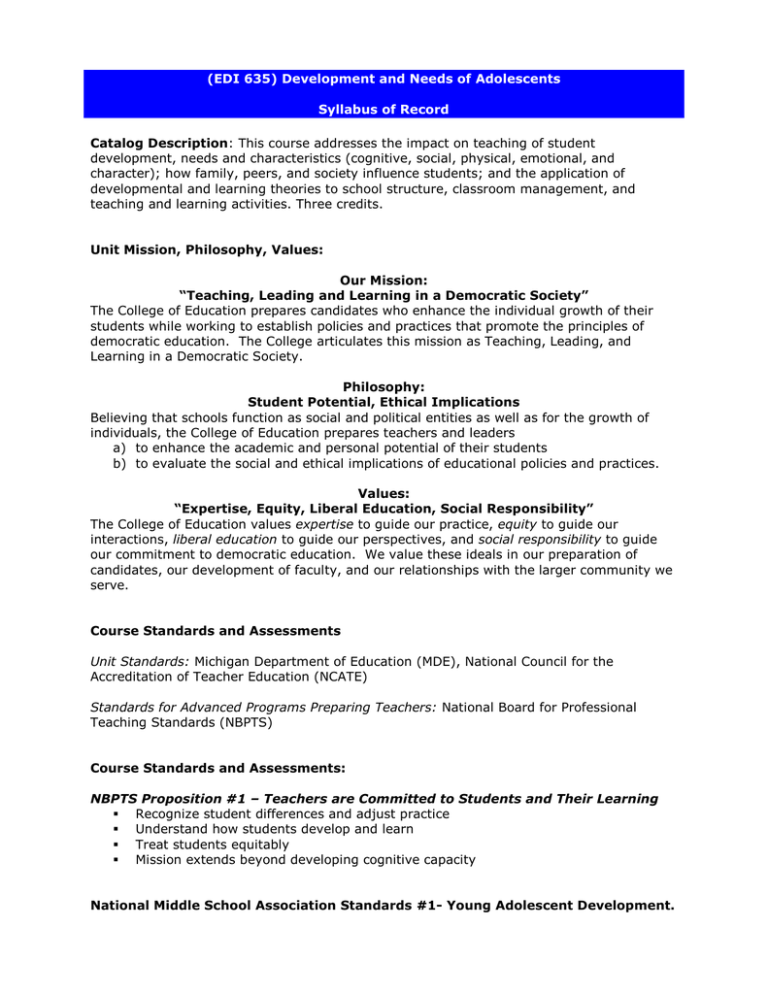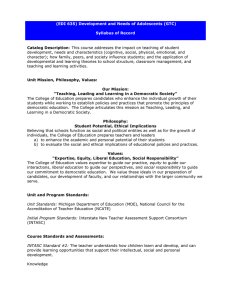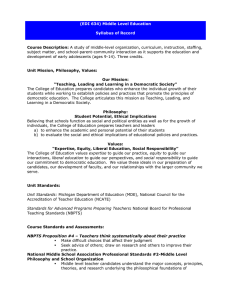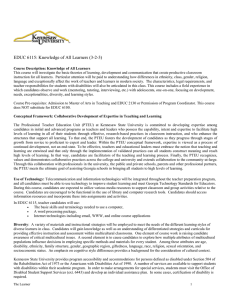(EDI 635) Development and Needs of Adolescents Syllabus of Record
advertisement

(EDI 635) Development and Needs of Adolescents Syllabus of Record Catalog Description: This course addresses the impact on teaching of student development, needs and characteristics (cognitive, social, physical, emotional, and character); how family, peers, and society influence students; and the application of developmental and learning theories to school structure, classroom management, and teaching and learning activities. Three credits. Unit Mission, Philosophy, Values: Our Mission: “Teaching, Leading and Learning in a Democratic Society” The College of Education prepares candidates who enhance the individual growth of their students while working to establish policies and practices that promote the principles of democratic education. The College articulates this mission as Teaching, Leading, and Learning in a Democratic Society. Philosophy: Student Potential, Ethical Implications Believing that schools function as social and political entities as well as for the growth of individuals, the College of Education prepares teachers and leaders a) to enhance the academic and personal potential of their students b) to evaluate the social and ethical implications of educational policies and practices. Values: “Expertise, Equity, Liberal Education, Social Responsibility” The College of Education values expertise to guide our practice, equity to guide our interactions, liberal education to guide our perspectives, and social responsibility to guide our commitment to democratic education. We value these ideals in our preparation of candidates, our development of faculty, and our relationships with the larger community we serve. Course Standards and Assessments Unit Standards: Michigan Department of Education (MDE), National Council for the Accreditation of Teacher Education (NCATE) Standards for Advanced Programs Preparing Teachers: National Board for Professional Teaching Standards (NBPTS) Course Standards and Assessments: NBPTS Proposition #1 – Teachers are Committed to Students and Their Learning Recognize student differences and adjust practice Understand how students develop and learn Treat students equitably Mission extends beyond developing cognitive capacity National Middle School Association Standards #1- Young Adolescent Development. Middle level teacher candidates understand the major concepts, principles, theories, and research related to young adolescent development, and they provide opportunities that support student development and learning. National Middle School Association Standards #6- Family and Community Involvement. Middle level teacher candidates understand the major concepts, principles, theories, and research related to working collaboratively with family and community members, and they use that knowledge to maximize the learning of all young adolescents. Common Assessment: Adolescent Research Project Major Topics: Perspectives and adolescence Puberty and biology Cognitive growth and education Identity and socio-emotional development Family relationships Peers and youth culture Teenage sexuality Problem behaviors and interventions Course Knowledge Base: Armstrong, T. (1994). Multiple Intelligences in the Classroom. Alexandria, VA: Association of Supervision and Curriculum Development. Bruer, J.T. (1999). In search of brain-based education. Phi Delta Kappan. 80(9), 649-657. Caine, R. N. & Caine, G. (1994). Making connections: Teaching and the human brain. Menlo Park, CA: Addison-Wesley. Dubas, J.S., Garber, J.A., & Peterson, A.C. (1991). The effects of pubertal development on achievement during adolescence. American Journal of Education. 99(4), 444-458. Duffy, Karen G. (2004). Adolescent Psychology. (4th ed.). Dubuque, IO: Mc Graw-Hill Dunn, R. (1995). Strategies for educating diverse learners. Fastback 384. Bloomington, IN: Phi Delta Kappa Educational Foundation. Eccles, J.S., Midgley, D., Wigtield, A., Buchanan, C.M., Reuan, D., Flanahan, C., & Maclver, D. (1993). Development during adolescence: the impact of stage-environment fit in young adolescents’ experiences in schools and in families. American Psychologies, 48, 90-101. Fitzgerald, R. (1996). Brain-compatible teaching in a block schedule. School Administrators,. 53(8), 20-21, 24. Gardner, H. (1996). Multiple intelligences: myths and messages. International Schools Journal. 15(2), 8-22. Goodlad, J., Soder, R., & Sirotnik, K. (Eds.). (1990). The moral dimensions of teaching. San Francisco: Jossey-Bass. Laziar, D. G. (1992). Teaching for multiple intelligences. Bloomington, IN: Phi Delta Kappa Educational Foundation. Marzano, R.J. (1992). A different kind of classroom: Teaching with dimensions of learning. Alexandria, VA: Association of Supervision and Curriculum Development. Schurr, S.L. (1995). Prescriptions for success in heterogeneous classrooms. Columbus, OH: National Middle Schools Association. Stinberg, L. (1996). Beyond the classroom: Why school reform has failed and what parents need to do. New York: Simon & Schuster. Vaughn, S., Bos, C. S. Schumm, S. (1997). Teaching mainstreamed, diverse, and at risk students in the general education classroom. Needham Heights, JA: Allyn & Bacon. Walker, H. (1998). First steps to prevent antisocial behavior. Teaching Exceptional Children. 30(4), 17-19.







